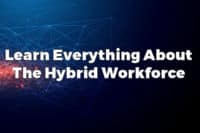Against all odds, the year 2020 and the advent of Covid heralded a new era in the business world. Contact centers and almost no industry has been spared, as working habits, job schedules, communication patterns and technologies have all been altered drastically.
The hybrid work environment is growing, and businesses are continuing to implement new technology to equip their employees with the necessary tools to work from home. However, there is rising worry about the environmental consequences of this. As we emerge from the epidemic, it’s apparent that the remote work model, in some form or another, is here to stay. As a result, the tools, technology, and procedures that contact centers will need to adapt to hybrid work patterns that must be carefully evaluated. Whatever the challenges that lie ahead, it appears that remote work, hybrid work teams, and more than ever, virtual contact centers will take center stage.
The stakes of hybrid workforce
 The hybrid workforce is a model that allows individuals to work from home and in the office. Employees in this hybrid model often telecommute 2-3 days per week and return to the office the rest of the time. However, this percentage is directly reliant on the rules of the business and might differ from one company to the next or even from one business owner to the next. The hybrid work paradigm is intended to provide employees greater flexibility, allowing them to work when and where they choose. Employees may now schedule their workdays around their personal lives, thanks to flexible hours and days.
The hybrid workforce is a model that allows individuals to work from home and in the office. Employees in this hybrid model often telecommute 2-3 days per week and return to the office the rest of the time. However, this percentage is directly reliant on the rules of the business and might differ from one company to the next or even from one business owner to the next. The hybrid work paradigm is intended to provide employees greater flexibility, allowing them to work when and where they choose. Employees may now schedule their workdays around their personal lives, thanks to flexible hours and days.
In that regard, the hybrid workforce offers several advantages. The biggest one is giving employees the freedom to work from anywhere they choose. Furthermore, businesses may now hire people from anywhere, providing them access to a larger pool of talent, especially if contact center decides to reduce the number of employees on site each day. However, like all work models, hybrid workforce doesn’t come without its challenges.
Advantages of the hybrid workforce model
Flexibility and Efficiency
Working remotely or in a hybrid manner allows for greater flexibility. As agents have greater control over their workload while they are naturally less solicited or bothered by the surrounding noise (discussions, coffee machine, etc.). Which allows them to be more concentrated and therefore more efficient. With a well-organized work environment, your agents can be more productive, opening the door to new initiatives, anticipation, and increased performance by allowing more time for perspective.
While it’s true that the contact center world is ruled by numbers, offering greater freedom to your agents as an business owners is also a sign of trust and will strengthen his drive toward the joint objective that is your contact center endeavor. Of course, remote work does not free you from exchanging with your teams, as all digital communication channels such as chats, emails, and videoconferencing are conveniently available to provide mobility and flexibility whithin your company.
Cost-effectiveness at both ends
The financial element of a hybrid approach is appealing to any business owner. Indeed, if you can assure that your teams rotate, you can opt to grow your human resources without increasing your locations expanses, by allowing workers to work from home, you can save money on office rent, furnishings, and upkeep. We can also talk about financial savings for your employees. By alternating days of presence and decreasing travel expenditures (car or public transportation), as well as lunches on the run, which can be felt at the end of the month for employees. Once again, happy agents means great productivity for your contact centers.
Picking the best talents for your business
Now that the work-from-home genie has fully unveiled on the market, many employees and talents are seeking for businesses that provide remote or hybrid workforce. By providing these alternatives, you can ensure that your contact center can attract the finest job candidates. Once again, happier employees perform better. Furthermore, happy employees equal lower turnover.
Downsides of the hybrid workforce model
Burnout is still looming in the remote work
If left uncontrolled, a burnout culture might infiltrate even in a hybrid workforce model. Consider this: your remote agents may work longer hours and take fewer breaks than their peers in the office. As they are afraid that their workplace colleagues will think they are slacking because they are out of sight, so they stay late or make themselves available outside of regular work hours to compensate.
When a remote agents takes sometime for themselves during the day, for example, to take care of their children, it might provoke emotions of guilt, resulting in more work, greater stress, and, eventually, burnout. It is up to business owners and supervisors to deliberately develop a business culture that focuses on the job itself rather than merely being linked through communication tools.
Increased reliance on technology
 Technology is always a double edged sword, as distancing from its physical location is a significant and complicated issue, but a hybrid workplace must be able to function regardless of location. This implies that everyone, no matter how far away they are from the office, should have the necessary gear and resources to do their tasks. The IT department of a hybrid office must be able to manage a wide range of different personal devices connecting from various places, not only to provide access for all employees, but also to keep the company’s data secure.
Technology is always a double edged sword, as distancing from its physical location is a significant and complicated issue, but a hybrid workplace must be able to function regardless of location. This implies that everyone, no matter how far away they are from the office, should have the necessary gear and resources to do their tasks. The IT department of a hybrid office must be able to manage a wide range of different personal devices connecting from various places, not only to provide access for all employees, but also to keep the company’s data secure.
In that regard, NobelBiz Omni+, a true omnichannel purposely built for all contact center neeeds, enabling businesses to relocate all their agents and workforce to a remote environment and return to the office in a matter of days, without disrupting productivity, KPIs or performances. Your agents only need a laptop, a headset, and an Internet connection. Furthermore, the interface of our contact center solution is one of the most agent-friendly on the market, effortlessly integrating calls, social medias, Webchat, E-mail and SMS, while improving operational interactions with a clean flow between supervisors and agents as well as a precise customer data flow.
Social disparity
It might be challenging to establish or sustain connections with all your employees in a Hybrid model workplace. After all, supervisors can’t just stroll over to their workstation and strike up a casual chat or show them a hilarious video if you don’t share the same physical location.
This critical disparity in employee experience becomes even more evident when certain agents continue to work in the office, since it forms insular groups that can leave remote agents feeling alienated, ignored, and lonely. A competent business owner may address this issue by making the company’s team-building activities available to all employees and by hosting frequent online events that are open to everybody, regardless of geography.
How to deal with the challenges of a hybrid workforce?
Hybrid workforce implementation, like any other system has its own hazards. Employees have less physical interaction as a result of spending less time in the workplace, resulting in less exchange of ideas amongst your teams. Another challenge to consider is fatigue and work spilling into personal life. These challenges, however, may be avoided with the right strategy. If you choose a hybrid work mode, here are the essential pieces you need to put in place and alter:
Implement a Flexible Management
 As you have guessed by now, managing a hybrid company is more difficult than managing a regular office company. Indeed, it is no longer possible to evaluate each person’s work just on the amount of time spent on a task. As a result, we are seeing the growth of the outcome culture, which emphasizes the job done and the metrics.
As you have guessed by now, managing a hybrid company is more difficult than managing a regular office company. Indeed, it is no longer possible to evaluate each person’s work just on the amount of time spent on a task. As a result, we are seeing the growth of the outcome culture, which emphasizes the job done and the metrics.
To keep teams engaged and committed, business owners must establish more frequent contact with each supervisors, agents and employees by prioritizing direct conversation modalities (for example, chat over e-mail and videoconference) in order to fluidify communication. These interactions, of course, should not be restricted to one meeting each week. Collaborating remotely entails being in touch with your colleagues, even if it’s only to see how they’re doing or to see if they need assistance with a certain campaign or specific tasks.
Adapting productivity tools
Many businesses have swiftly embraced remote work without necessarily providing the tools necessary for employees to work successfully. Examples include problems such as inaccessible mobile computer equipment, internet network, and difficult access to information owing to physical rather than digital storage. Here are some best practices:
- Defining and improving the list of required equipment by position, based on roles and responsibilities, while considering ergonomic factors, such as headset, laptop, screens, etc;
- Analyzing current infrastructure and software to determine if they are appropriate for the work organization formula chosen (e.g.: integrated management system to ensure the integrity, telephony solution, and availability of the information required to perform the work).
- And most important cybersecurity, which is increasingly necessary, both on the company’s premises and when working remotely.
Formalizing a new communication structure
Many contact centers still rely on face-to-face communication that is informal. Internal communications will need to be more organized and structured as a result of adopting a hybrid work mode to guarantee that the necessary information flows in a two-way fashion and is conveyed to all relevant employees.
Furthermore, contact center will need to create criteria for determining which meetings should be held face-to-face and which may be done remotely. Criteria might include the meeting’s KPIs, subjects to be addressed, individuals to be reached, and segmentation of new client databaes. To put it simply, in the hybrid environment you need to:
- Identify and improve the list of current meetings
- Ensure that all levels of managements are represented (e.g., team meeting, management committee, campaign launch, etc.);
- Determine the main objectives of the meeting, the participants, and the recommended method (face-to-face or digital communication channels).
Human resource management processes must be adjusted
When it comes to work organization, all human resource management practices are impacted. Organizations that use a hybrid mode will definitely need to modify their procedures to ensure that they are compatible with the orientation chosen. Contact centers must explain their expectations of remote and office employees from the start, through consultation in the form of a survey and the implementation of a formal remote work policy, which includes:
- Modifying the onboarding process for new employees so that they may meet their new colleagues and establish a sense of belonging to the business as soon as they arrive;
- Adapting the communication technique utilized during employee performance assessments (face-to-face or virtual meetings);
- Meetings should ideally be face-to-face, but supervisors may need to adjust to the location and format of the meeting;
- Review performance evaluation standards as performance evaluation will need to be more focused on producing outcomes;
- Protect employees’ health and well-being by implementing a right to disconnect policy.
Is Hybrid Workforce a good idea?
 Although the hybrid model is a challenge for companies, this transformation has several benefits and will undoubtedly signal a watershed moment in the world of business. Whether you choose to use this strategy or not, you must be attentive to your staff throughout this period of change and demonstrate flexibility and openness as a business owner.
Although the hybrid model is a challenge for companies, this transformation has several benefits and will undoubtedly signal a watershed moment in the world of business. Whether you choose to use this strategy or not, you must be attentive to your staff throughout this period of change and demonstrate flexibility and openness as a business owner.
Whether your staff is remote, at the office or hybrid, the coming year is sure to be full of more surprises. It’s important to invest in technologies that help your agents and teams collaborate seamlessly, allowing them to deliver an exceptional experience for your clients. And it is paramount to nurture a culture of collaboration, support and communication whithin your organization.

Abdelmounim Benharouga has always had a strong passion for writing and digital marketing. He started as a Digital Content Writer part of marketing department then moved to being Customer Success Manager for the African Region within the Nobelbiz team.







